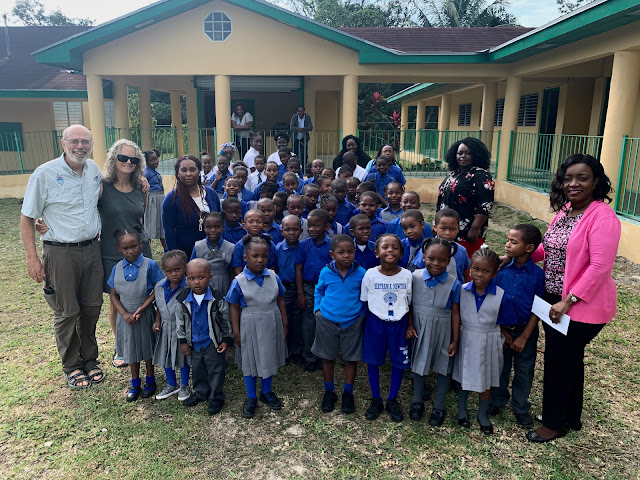 |
| Tory swam to check on Molly as we enjoyed the beach on Spanish Wells. |
 |
| We found some great beach glass on the Bimini beaches, some of it no doubt from the remains of homecoming parties over the decades past. |
 |
| Our 2nd Bimini marina was very quiet. As usually, we are the smallest cruising boat. |
The size of the loudspeakers in an open lot next to the
marina should have been the giveaway. Multiple
speakers were strapped together, 6 feet tall and 10 feet wide, on both sides of
the DJ. When the music started, it was
easily over 100 decibels, but the killer was that the bass overwhelmed
everything. I tried to sleep with by
pillow over my ears, but the bass vibrations seemed to only be further
magnified. The first night, a Wednesday
(3/27), the music went until 1 am. The
second night until 2 am. It was time to
switch to a quiet marina 2 miles away.
 |
| The waters at sunrise for relatively calm for a Gulf crossing. The cruise ship is anchored off North Bimini. |
The Gulf crossing began at sunrise and was about as smooth as it could be as we averaged 17-20 mph and arrived at the West Palm Inlet around noon. We then fueled up at nearby Sailfish Marina, and home to one of the largest sports fishing fleets in the country. The dockhand told me that cash prices for trophy fish can be over $500,000.
We then cruised our last miles to Indiantown Marina, near Lake Okeechobee, to prepare Salty Paws to be pulled from the water. Our truck and trailer have been stored for the last two months. Our
cruising is done until summer. But we will use the boat as an RV while heading back to Maine.

We enjoyed talking and listening to our dockmates and also
overhearing some of talk. Jeff and Linda,
next to us on the dock, are moving off their sailboat to return to Canada. This exchange took place
Jeff: “I had a terrible afternoon.”
Linda: “What happened, honey?”
Jeff: “I hit a cow with our truck!”
Linda: “Oh, no.”
Jeff: “The ‘f….ing’ cow was just standing in the middle of the road! Can you believe that?
Linda: How is the cow?
Jeff: Dead, and the farmer was really
pissed.”
Linda: “Sorry that the farmer took it out on you.”
Jeff: “He wasn’t mad at me. He was mad at the cow!”
I do not know if we will ever return to the Bahamas. Four trips are enough for Molly, and the
weather by all accounts has been much windier over the last two winters. Some of our cruising friends have had spend a few
weeks in one protected spot to find a sufficient weather window to cruise between islands.
We do love the beautiful anchorages, the people, the
waters and the nearly perfect temperatures. I went back over our blogs documenting our visits in 2016-17, 2020, 2022 and 2024. Here are some of the top experiences that we treasure.
Beautiful Anchorages

There is not a more picture perfect anchorage than the Exuma Land and Sea Park. We stayed here in 2017 and 2020.
 |
| The best anchorage in the Abacos is off Sand Cay between the Double-Breasted Cays. Molly and I spend 3 days there in 2022, and Dave Powers and I anchored there earlier this year (2024). |
 |
| Molly with Aaron. Was he really the museum director? |
 Community Unknown for Almost 100 Years Beginning in the 1820's or so, Florida was increasingly a brutal ground for both Native Americans and formerly free blacks. The US Army was in a campaign to exterminate the Seminoles, and blacks, formerly free under Spanish rule, were often enslaved by whites who were establishing plantations in the new state. Beginning in the 1830's a number of Seminoles and slaves escaped Florida by crossing the Gulf Stream in open boats to the shallow western shore of Andros Island. There, they established the community of Red Bays, that was unknown to the outside world until 1930.
Community Unknown for Almost 100 Years Beginning in the 1820's or so, Florida was increasingly a brutal ground for both Native Americans and formerly free blacks. The US Army was in a campaign to exterminate the Seminoles, and blacks, formerly free under Spanish rule, were often enslaved by whites who were establishing plantations in the new state. Beginning in the 1830's a number of Seminoles and slaves escaped Florida by crossing the Gulf Stream in open boats to the shallow western shore of Andros Island. There, they established the community of Red Bays, that was unknown to the outside world until 1930.
 No picture does full justice to the Bahamian water. After crossing the Gulf Stream from Florida, cruisers know they have arrived in the Bahamas once they reach the turquoise waters of the shallow banks that can extent for over 100 miles. Water depths are typically 10-15 feet, but the clarity makes it seem that the water is much less than that.
No picture does full justice to the Bahamian water. After crossing the Gulf Stream from Florida, cruisers know they have arrived in the Bahamas once they reach the turquoise waters of the shallow banks that can extent for over 100 miles. Water depths are typically 10-15 feet, but the clarity makes it seem that the water is much less than that. |
| We snorkeled near choral reefs, and usually found schools of colorful fish. |
 |
| Conch is plentiful throughout the Bahamas and often used for fritters and salads. |
 |
| Here I am snorkeling down to the stainless steel piano placed by David Copperfield off the cay that he owns. |
 |
| That blob is an octopus! |
 |
| They were hard to see, but we finally found a seahorse. |


